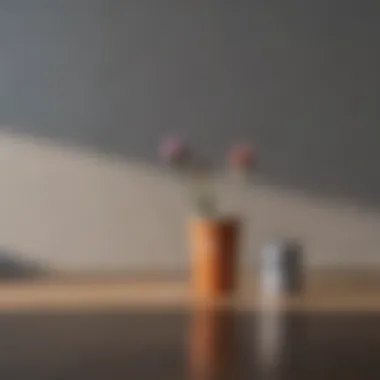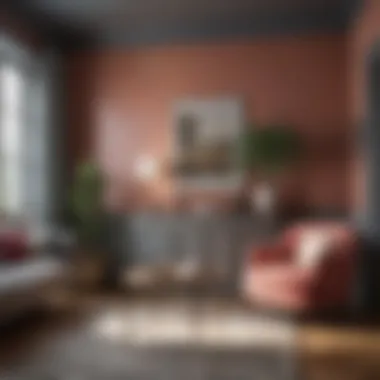Understanding the Cost to Paint Rooms in a House


Intro
Paint can transform a room, making it more inviting and visually compelling. However, understanding the cost of painting rooms is essential for homeowners and interior design enthusiasts alike. Several factors influence the overall expense, including room size, paint type, and labor costs. Knowing these elements can help you plan your project effectively.
Economical management of painting projects enhances quality and efficiency. This article will guide you through the various aspects of painting costs, providing insights on how to achieve your desired look while staying within your budget. Whether you are a homeowner looking to refresh your living space or an enthusiast eager to learn more, this guide serves as a valuable resource.
As you prepare for a painting project, clarity on these subjects positions you to make informed decisions, minimizing surprises along the way. The following sections will explore important considerations, including design inspiration that complements cost considerations.
Intro to Painting Costs
Understanding the costs involved in painting rooms within a house is an essential concern for homeowners and anyone engaged in residential redesign. Painting is not often just about aesthetic appeal; it is a fundamental part of home maintenance. This undertaking can transform a space, but it comes with a price that varies based on multiple factors.
Overview of Room Painting
Room painting involves much more than simply applying a fresh coat of paint. Initially, one must consider the room's dimensions, existing conditions, and the overall desired outcome. The types of paint available are diverse. They range from high-quality finishes to budget-friendly options, and selecting the right one can significantly influence the final costs.
Moreover, the painting process entails various stages. This includes preparing the surfaces, applying multiple layers, and ensuring that the finish meets expectations. Homeowners should not underestimate the effort that goes into these stages, as they contribute significantly to the overall financial investment. Therefore, a keen understanding of what room painting entails is pivotal.
Importance of Understanding Costs
Grasping the costs associated with painting is crucial for effective budgeting and planning. Surprisingly, many underestimate how these costs accumulate, often overlooking essential aspects like preparation and labor.
A clear perspective on expenses allows homeowners to make informed decisions. When understanding the budget, one can prioritize quality over inexpensive options, leading to better long-term value. Prospective painters who engage in this foundational knowledge can set realistic expectations for their projects.
Informed homeowners can avoid common pitfalls, such as unexpected expenditures and reduced satisfaction with results.
This section establishes a comprehensive groundwork on the importance of understanding painting costs. It prepares future discussions by emphasizing the need to scrutinize each facet of the painting process, from selecting the right materials to considering labor services. Without this knowledge, one risks embarking on a painting project unprepared, which can lead to dissatisfaction, increased costs, and wasted time.
Factors Influencing Painting Costs
Understanding the factors that influence painting costs is crucial for anyone considering a painting project. These elements help owners and contractors estimate expenses accurately and make informed decisions. Factors vary widely, and their impact on total costs depends on how they interplay in each unique situation. Thus, recognizing these key variables will lead to better planning and the potential to save money without sacrificing quality.
Size of the Room
One of the primary determinants of painting cost is the size of the room. Larger spaces require more paint and time to cover, naturally driving up costs. For instance, a small bedroom typically costs less to paint than an expansive living room. The total square footage is calculated by measuring the walls to be painted. It is important to include doors and windows in this calculation, as these elements reduce the paintable area, which can affect the cost per square foot.
Paint Quality and Type
The quality and type of paint chosen also significantly influence the overall painting cost. Low-quality paints might save money upfront, but they often require more coats and may not last as long. On the other hand, high-quality paints, like Benjamin Moore Regal Select or Sherwin-Williams Emerald, cost more initially but provide better coverage and durability. Consumers should also consider specific needs, such as matte, glossy, or specialty paints. Choosing eco-friendly options may have higher upfront costs but can benefit the environment and the health of residents in the long term.


Labor Costs
Labor costs further complicate the painting price structure. Professional painters often charge by the hour or based on the square footage of the area. Rates can vary depending on the contractor's experience and location. Often, hiring a reputable contractor, despite higher fees, assures quality workmanship. Homeowners must factor in these costs when budgeting.
Preparation Work Needed
Preparation work can significantly affect painting expenses. Before applying paint, walls may require cleaning, patching, or priming. In instances where surfaces are damaged or previously painted with a dark color, additional prep can be labor-intensive. Proper preparation is key to ensuring a smooth and lasting finish, hence any neglect may result in additional costs down the road.
Post-Painting Requirements
After the painting process is complete, additional tasks may arise. This can include removing tape, cleaning up, or applying a second coat for consistency. Installation of baseboards or touch-ups could also incur extra charges. Homeowners need to consider these potential post-painting requirements in their planning.
"Understanding the full scope of costs involved in painting a room is essential for effective budgeting and project management."
In summary, various factors influence the painting costs extensively. Recognizing each of them enables clearer budgeting and improved decision-making when undertaking a painting project.
Estimating Costs: A Breakdown
Estimating the costs associated with painting rooms is a vital aspect of planning any painting project. This section aims to clarify the financial implications involved, helping homeowners make informed decisions. Knowing how to break down expenses contributes greatly to managing your overall budget.
Many factors emerge when it comes to estimating these costs. Understanding how to calculate the expenses can lead to better financial planning. You will feel prepared to tackle your specific project and avoid overspending.
Cost Per Square Foot
When it comes to understanding painting costs, the measure of cost per square foot is critical. This calculation provides a fundamental basis for budgeting and helps establish an overall price range. To determine this, you must assess the total area to be painted and then multiply it by the local market rate for painting services. Knowing the average cost per square foot in your area can assist in guiding your decisions.
For example, in urban settings, prices often range from $1.50 to $3.50 per square foot. Conversely, rural areas may see lower rates, around $1.00 to $2.50. These figures reflect labor and material costs, but they can vary based on quality and demand.
Additionally, some painters might offer rates per room instead. Understanding the square footage of each room can provide better insight for potential costs.
Average Price Ranges
By exploring average price ranges, one can grasp the broader context of painting expenses. Many aspects, such as location, room function, and access, come into play.
Interior vs. Exterior Rooms
Painting interior rooms generally proves to be less expensive than exterior ones. Interior spaces often require simpler preparation and fewer materials. For instance, exterior walls need weather-resistant paints and often more extensive prep work to ensure durability.
The price range for interior painting can average between $200 to $800 per room, contingent on size and complexity. On the other hand, exterior painting often lands in the range of $300 to $1,500 for a standard-sized house. Here, the costs can escalate based on factors like height and surface texture.


One Coat vs. Two Coats
When deciding between applying one coat or two coats of paint, consider durability versus cost. Generally, two coats are recommended for optimal coverage, especially if changing colors.
Using one coat might reduce immediate expenses, but you may end up needing a touch-up sooner. In contrast, although two coats can increase costs initially, they often provide lasting results. The trade-off here is an upfront investment that will likely offer better longevity.
DIY vs. Professional Painting
Choosing between DIY painting and hiring professional services is another important consideration.
Opting for DIY painting can commonly save you money, but it also demands time and effort. It is a practical choice for smaller or less complex jobs. However, lack of experience may result in less satisfactory outcomes, potentially increasing future costs.
On the other hand, professionals bring expertise and efficiency to the project. While their services may appear higher in cost, they often complete jobs with better results and save time. Generally, for larger projects, this can prove more economical than doing it yourself.
Strategic Planning for Your Painting Project
Strategic planning is imperatively critical when embarking on a painting project. The effectiveness of the entire endeavor often hinges on how well the project is organized ahead of time. Engaging in thoughtful preparation not only helps in costing accurately but also in avoiding unforeseen complications during the painting process. This approach ensures that the project is executed smoothly, aligning both time and financial resources to achieve a satisfactory result.
Budgeting
Setting a Project Budget
Setting a project budget is a fundamental step that structures the financial constraints of a painting initiative. It enables homeowners to estimate the overall expenses and delineate where funds should be allocated. One primary characteristic of establishing a budget lies in its potential to curb excessive spending. By determining a cap on the costs, it becomes more manageable to prioritize essential components such as paint selection and labor costs.
Furthermore, establishing a budget before starting the project allows for a clearer comparison of estimates from contractors or paint suppliers, helping in making informed decisions. However, if the budget is not realistic, it may lead to cutting corners or compromising on quality, which can lead to dissatisfaction with the final result. Therefore, a well-researched and realistic budget is vital in maintaining both quality and financial integrity in any house painting project.
Contingency Funds
Contingency funds are an essential component of any painting budget. They act as a financial buffer designed to cover unexpected expenses that can arise during the renovation process. The key characteristic of contingency funds is their flexibility; they allow adjustments without derailing the entire budget. This is particularly advantageous because hidden costs can surface at any moment—such as wall repairs, additional coats of paint, or changes in material prices.
A unique feature of setting aside contingency funds is that it fosters peace of mind. Homeowners can engage in the painting project with less anxiety about running over budget. However, it should be noted that this practice may also encourage careless oversight if those attached funds are mismanaged or spent on unnecessary luxuries. Thus, while contingency funds can be beneficial, they require careful planning and application.
Choosing the Right Materials
Choosing the right materials significantly influences the overall cost and outcome of the painting project. Options like paint types, finishes, and quality can vary extensively and must match the visual and functional needs of the space. Ya wanna ensure that you select paints that not only align with aesthetic preferences but also offer durability commensurate with the room's usage.
Various paint finishes can affect longevity and maintenance, influencing the necessity for future painting. This, in turn, makes initial choices exceedingly impactful long-term. For example, using high-quality, washable paints can reduce the frequency of needing touch-ups or complete repaints, which ultimately saves money over time.
Scheduling the Work
Scheduling is a critical factor in ensuring that a painting project unfolds efficiently. By creating a timeline for each phase of the work—such as preparation, painting, and post-painting touch-ups—one can allocate sufficient time to each task. Proper scheduling can also help avoid conflicts, particularly when working with contractors or organizing around family's routines.
Additionally, examining factors such as seasonality or weather can enhance the planning stage. Understanding when to undertake the job can lead to a better outcome.


Effective strategic planning is essential. It enhances the chances for a successful painting project while managing costs and maintaining quality.
Additional Considerations
When contemplating a painting project in your home, approaching the cost effectively requires attention to several additional considerations. These elements may not always be the first to come to mind, yet they can significantly shape the overall expenses and satisfaction derived from the completed work. By assessing them carefully, you can avoid unpleasant surprises and ensure that both the financial and aesthetic aspects align with your expectations.
Environmental Impact
The environmental impact of painting should not be overlooked. Traditional paints can contain harmful volatile organic compounds (VOCs), which may evaporate into the air and contribute to indoor air pollution. This aspect is critical, especially for homes with children or individuals with sensitivities.
Choosing low-VOC or zero-VOC paints can mitigate these risks and foster a healthier living environment. Further, it can also reduce the carbon footprint associated with manufacturing and transporting paint. Therefore, not only are you making a choice that could affect your immediate surroundings, but you are also playing a role in broader environmental stewardship. Ultimately, understanding the environmental repercussions of your materials lays a foundation for responsible decision-making during your project.
Choosing Eco-Friendly Paints
Selecting eco-friendly paints presents numerous benefits. These paints generally undergo rigorous testing to ensure safety and minimal environmental impact. Some of the options available include natural paints, made from ingredients such as clay or chalk, and biodegradable paints, which break down and return to nature without harmful residual effects.
Using eco-friendly paints can enable you to:
- Improve Indoor Air Quality: Many of these products emit fewer harmful substances over time.
- Support Sustainable Practices: Many manufacturers prioritize responsible sourcing and sustainable production methods.
- Enhance Aesthetic Appeal: Eco-friendly options offer a wide variety of colors and finishes that can suit any decor style.
You must research and seek certified products that align with your commitment to the environment. Websites like Wikipedia and Britannica can provide valuable information on the various types of eco-friendly paint available. Remember, the benefits extend beyond just visual appeal; they encapsulate health, sustainability, and ethical considerations that resonate with conscious consumers.
"Opting for eco-friendly paints is more than a choice; it is a proactive step towards a sustainable future."
Choosing the right materials can help you achieve not just a beautiful space but also a lasting positive impact.
Ending
Understanding the costs associated with painting rooms in a house is essential. The financial aspect goes beyond merely the price of paint. It encompasses the entire project lifecycle, including preparation, labor, and post-painting work. Homeowners need to grasp these elements to manage their expenses effectively and ensure both quality and satisfaction in the end result.
Summarizing Key Points
To summarize the critical aspects of painting costs covered in this article:
- Room Size: Larger rooms require more materials and labor, directly impacting the overall cost.
- Paint Quality and Type: Higher quality paints may increase upfront costs but provide longevity and durability.
- Labor Costs: Hiring professionals can significantly add to total expenses; understanding their rates and expectations is vital.
- Preparation Work: Additional steps to prep a room can add time and expense.
- Post-Painting Requirements: Aftercare can involve touch-ups or additional clean-up that influences the final budget.
By considering these factors, homeowners can plan their projects better. They can allocate funds more wisely, anticipating various costs rather than just focusing on initial paint purchase.
Final Thoughts on Painting Costs
Understanding the costs ahead of time empowers homeowners to make informed decisions. The anticipation of expenses and the planning involved leads to manageable budgets and successful project execution. Ultimately, when done right, painting can enhance the living space while being a financially responsible endeavor.
"By understanding the comprehensive cost structure of room painting, homeowners can not only save money but also enhance the value of their property."
This approach ensures an understanding that painting is not just about changing colors but also about improving the quality of life within the home.



